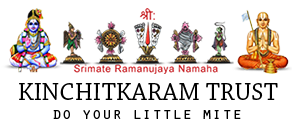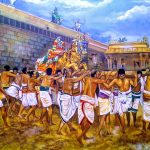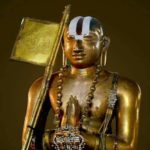Srimathe Ramanujaya Namaha,
Namaskaram Badri Swami,
Due to devareer tailgating on this question, “As per sastras, Is intercaste marriage allowed? If no, is this applicable to Prappanas as well?, adiyen would like to share some references and Inference with Acharya ThiruvAdi Bhalam and Velukkudi Swami’s Aasirvadham.
Catergory-1 “Athma Vivaham”
Answer is “Yes”. For Prapannas (Sharanagathas) Intercaste Marriage is the ONLY Allowed Marriage. How? as below.
Prapannas focus is Elite thinking, that we consider ourselves as JeevAthma (Sookshma) beyond this Shareeram/Body (Sthoolam).
One becomes a “Prapanna” when we do Sharanagathy On BhagavAn Sriman NarayanAn’s Lotus feet.
So Velukkudi Swami has said there are two types of Jaathi (caste) for Sookshma view point as per Shastras.
- Swa-Jaathi : Means Same Jaathi/Caste. These are each of us “The JeevAthma’s” which are countless covered with an outside body (sthoolam) either as Deva or Humans …..or Animals, Birds etc….and each of the JeevAthmas are Gyana Swaroopam (Only made of Spiritual Knowledge) & Parathanthran (servant to the ONE Almighty GOD) when detached from Karmas/Vaasanas/Ruchi.
- Vi-Jaathi : Means one who doesn’t belong to the Swa Jaathi category. This is ONLY ONE in this category called “The ParamAthma”. We call as “Sriman NarayanA”, others call as “The Almighty GOD” etc…
So, when one does Surrender to The Almighty GOD, we Jeevathmas are called as Prapannas and this type of marriage is called as “Athma Vivaham” between JeevAthma & ParamAthma ONLY. So in this Sooksham view point from Shastra, only INTER-CASTE” marriage is allowed. Two Athmas cannot marry each other.
Catergory-2 “Shareera Vivaham”
Answer is “Yes & No both”. This is marriage between two JeevAthma’s ALONG with their own Shareera/Body from Sthoola view point.
For this type Manu Smrithi 3-21 says about “Ashta Vivah” Eight types of marriages.
Brahmo-daivastathaivarsah
prajapatya-statha ‘surah
Gandharvo raksasascaiva
Paisavastamah smrtah
The eight types are: brahma, daiva, arsha, prajapatya, asura, gandharva, rakshasa and paishacha, which adiyen pulled from SriVaishnava blogs.
‘1) Brahma Vivah:
After the student bachelor has completed his gurukulavasa, his parents approach the parents of a girl belonging to a good family and ask them to give away their daughter in marriage to their son–to make a gift of their daughter (kanyadana) to him. A marriage arranged like this is brahma. In it this girl’s family does not give any dowry or jewellery to the boy’s family. There is no “commercial transaction” and the goal of a brahma marriage is the dharmic advancement of two families. Of the eight forms of marriage the dharmasastras regard this as the highest.
Example Sita-Rama marriage. This is ideal marriage. The Groom seeking for Bride’s side.
‘2) Prajapatya Vivah:
In prajapatya there is no trading and kanyadana is a part of it as in the brahma ceremony. But from the name prajapatya it must be inferred that the bride’s menarche is imminent and that a child must be begotten soon after the marriage. For this reason the bride’s father goes in search of a groom, unlike in the brahma type. The brahma type is a better type of marriage than prajapatya since, in it, the groom’s people go seeking a bride who is to be the Grahalaksmi of their household.
‘3) Daiva Vivah:
Marrying a girl to a rtvik (priest) during a sacrifice is called “daiva”. The parents, in this type, after waiting in vain for a young man to turn up and ask for their daughter’s hand, go looking for a groom for her in a place where a sacrifice is being conducted. This type of marriage is considered inferior to brahma. In the sastras womanhood is elevated in that it is the groom’s family that has to seeking bride for their son.
‘4) Arsha Vivah:
“arsha” suggests that it is concerned with the rhisis, sages. It seems the marriage of Sukanya to Cyavana Maharsi was of this type. But from the dharmasastras we learn that in arsha, the bride is given in exchange for two cows received from the groom. If the term is taken to mean “giving away a girl in marriage to a rishi”, we must take in this Practical world, that the girl is married off to an old sage because the parents could not celebrate her marriage according to the brahma rite at the right time. The fact that cows are taken in exchange for the bride shows that the groom does not possess any remarkable qualities. According to the sastras, in marriages of noble kind there is no place for money or anything smacking of a business transaction.
‘5) Gandharva Vivah:
The very mention of it calls to mind Sakuntala and Dusyanta. The gandharva type is the “love marriage” that has such enthusiastic support these days.
‘6) Asura Vivah:
In the asura type the groom is in no way a match for the girl, but her father or her relatives receive a good deal of money from the man who forces them to marry her to him. In arsha in which cows are given in exchange for the bride there is no compulsion. Nor is the groom wealthy or powerful like his counterpart in the asura type. Many rich men must have taken a second wife according to the asura type of marriage.
‘7) Rakshasa Vivah:
In this Rakshasa type, the bride groom battles with girl’s family, overcomes them and carries her away. It was in this manner that Supreme BhagavAn SriKrishna ParamAthma married Rukmini PIratti. Also SriKrishna entertained same type marriage between Arjuna & Subhadra. In general, Humans have to avoid this type marriage unless girl is good behavior and stuck up in an atrocious family.
‘8) Paishacha Vivah:
The eighth and last is paishacha, MOST dangerous Type marriage. In asura type, even though the girl’s willingness to marry the man is of no consequence, at least her people are given money. In rakshasa type, though violence is done to the girl’s family, the marriage itself is not against her wish. Rukmini loved Krishna, did she not? But In paisaca the girl’s wish does not count, nor is any money or material given to her parents. She is seized against her wish and her family antagonized. This type of Paishacha marriage is when the bride is intoxicated or not in conscious state of mind and is unwillingly married off.
This type is totally devastating type for the girl and her family and society. So this type Paischa marriage is NOT acceptable type as per Manu Dharma Shastras and is OUTLAWED by MANU. The Nasthikas (Atheists) instead of not reading Manu dharma shastras properly, they start commenting with biased mind that Manu dharmam allows eight type of marriages and Paiachas is one among them, when in actual Manu dharma Shastra DENIES such marriages. This is how general people are being misled by Atheists.
Further to this there are sub-castes which is being developed by Humans for their convenience to follow their own Kula Dharmam of any varnas, since it will be difficult for one kula Varna to follow other kula Varna in general family practice. Hence, sub-inter caste marriages were avoided to keep their own family tradition without interruption in ideal world. But, adiyen believe, there are no strict rules as per Shastras for Inter-caste marriages, unless BhagavAt Bhakthi/Kainkaryam is the focus of the couples, then they are automatically considered in Catergory1 “Athma Viavah” though in Catergory2, they were in “Shareera Vivah” of human made same sub-castes or different sub-castes.
Kurai Irundhaal, adiyenai kShamikka Prarthikkiraen,
Nirai Irundhaal, Adiyenudaay Acharyan kirupayaal & Sri Velukkudi Swami Aasivadhatthal.
Adiyen (ElayaAlwar) Srinivasa (DhodayaAcharyar) Dasan.



